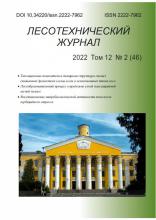Voronezh, Voronezh, Russian Federation
Source of release of harmful gas of wood particle board (WPB) – formaldehyde is not only free formaldehyde presenting in the formaldehyde resin, but formaldehyde, which is formed from hydroxymethylene groups in a weakly acidic environment during curing the resin during hot pressing of boards. In this, dimethylaniline connections are formed. They are unstable and go into methylene linkages (bridges) with the release of formaldehyde. Currently, with the goal of reducing the discharge formaldehyde from the boards of, low-molal urea-formaldehyde resin is used, mole ratio in which (carbamide (C) : formaldehyde (F) in resins preparing is at the level of (1:1.2 – 1:1.35). Thus we obtain resin with low content of free formaldehyde (0.10-0.15 % by weight of liquid resin). However, it is known that to obtain resins with good adhesive ability, and thus obtaining boards with good physical and mechanical and performance properties, excess of formaldehyde is necessary in its reaction with carbamide. With a relatively small excess of formaldehyde in the starting mixture of urea-formaldehyde we get resins with low reactivity. With increasing quantities of formaldehyde, it is growing vigorously. The highest reactivity corresponds to the mole ratio of carbamide and formaldehyde (C:F) 1:2. When the mole ratio of C:F=1:1 in the synthesis process substances are formed which have no adhesion to the wood. Therefore, the use of low molal resin in wood particleboard technology has not only its positive side (reduced evolution of formaldehyde from plates) but also negative ones (deteriorating physical and mechanical properties of the plates). In this regard for obtaining low-toxic wood particleboard, except for use of low-toxic resins in the technology, it is necessary to apply effective acceptor of formaldehyde. Moreover, it is advisable to use acceptor complex action, which not only linked formaldehyde in the boards, but also improves physical and mechanical and special properties of boards (bio-, water-, atmospheric constancy, etc.).
wood particle board, toxicity, formaldehyde, free formaldehyde, carbamide, mole ratio.
Использование в технологии ДСтП малотоксичных, низкомольных карбамидо-, фенолофор мальдегидных смол для снижения выделения из плит формальдегида является актуальным направлением. Однако в связи с повышенными требованиями Минздрава РФ к содержанию формальдегида в воздухе (предельно-допустимая концентрация (ПДК) должна быть не выше 0,01 мг/м3 воздуха) получить плиты классов эмиссии формальдегида Е0,5 и Е1 по действующему ГОСТ на ДСтП (10632-2014 [1]) только за счет использования в технологии плит малотоксичных смол не представляется возможным.
1. GOST 10632-2014. Plates are wood-shaving. Specifications. Interstate standard
2. Roffael, E. 1975: Messung der Formaldehydabgabe. Praxisnahe Methodezur Bestimmung der Formaldehydabgabe harnstoffharzgebundener Spanplatten. Holz-Zentralblatt 101, 1403-1404.
3. Petersen, H., Reuther, W., Eiselen, W. und O. Wittmann. 1974: Zur Formaldehydabspaltung bei Spanplattenerzeugung mit Harnstoff-Formaldehyd-Bindemitten; 3. Mitt.: Der Einfluss von Harterart, Hartermenge und formaldehydbindenden Mitteln. HolzRoh-Werkstoff 32, 402-410.
4. Marutzky, R., Roffael, E. und L. Ranta. 1979: Untersuchungenuber den Zusammenhangzwischen dem Molverhaltnis und der Formaldehydabgabe bei Harnstoff- Formaldehyd-Leimharzen. HolzRoh-Werkstoff 37, 303-307.
5. Kol, HS.,Keskin, H., Korkut, S., Akbulut, T. Laminated veneer lumber from Rowan (SorbusaucupariaLipsky) / African journal of agricultural research // HS. Kol, H. Keskin, S. Korkut, T. Akbulut. - OCT 2009. - P.1101- 1105.
6. Experimental study on flexural behavior of glulam and laminated veneer lumber beams / Liu, W. Q. Yang, H. F. Dong, F. Q.,[et al.] // Modern bamboo structures: Conference: 1st International Conference on Modern Bamboo Structures Location: Hunan Univ, Changsha, PEOPLES R CHINA Date: OCT 28-30, 2007. - 2008. - P. 159-169.
7. Liu W.Q. Yang H.F. Dong F.Q. [et al.] Experimental study on flexural behavior of glulam and laminated veneer lumber beams. Modern bamboo structures: Conference: 1st International Conference on Modern Bamboo Structures Location: Hunan Univ, Changsha, PEOPLES R CHINA Date: OCT 28-30, 2007, 2008, pp. 159-169.
8. Kol H.S., Keskin H., Korkut S., Akbulut T. Laminated veneer lumber from Rowan (SorbusaucupariaLipsky). African journal of agricultural research. OCT 2009, pp. 1101-1105.
9. Li H.Y., Li C.C., Gao Q., Zhang S.F., Li J.Z. Properties of soybean-flour-based adhesives enhanced by attapulgite and glycerol polyglycidyl ether/ Industrial crops and products. AUG 2014, pp. 35-40.
10. Budakci M. The determination of adhesion strength of wood veneer and synthetic resin panel (laminate) adhesives. Wood research, 2010, pp. 125-136.
11. Schwarzman G. M., D. A is generous. Production of wood-shaving plates. M, Forest industry, 1989, 318 pages.
12. Schwarzman G. M., D. A is generous. Production of wood-shaving plates. M, Forest industry, 1977, 322 pages.
13. GOST 10632-77. Wood chipboards. Specifications
14. GOST 10632-89. Wood chipboards. Specifications
15. GOST 10632-2007. Wood chipboards. Specifications
16. Volynsk V. N., Glue and paints and varnishes of domestic production (reference book). Arkhangelsk, 2000.












